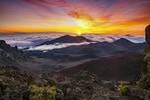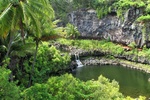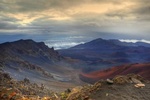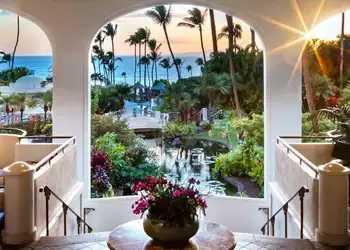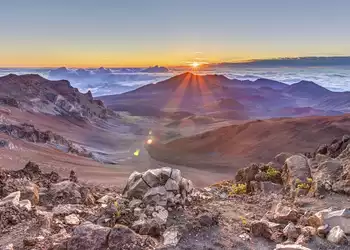The Hawaiian islands are home to serene beauty and natural landscapes that will take your breath away. Visitors flock to the island year after year to take in Hawaii’s beauty, and participate in the many ocean activities that the island is known for.
One of the preferred activities on the islands of Hawaii is hiking. Visitors can experience the incredible mountain ranges of Hawaii, along with the sights that are accompanied by volcanoes. The Haleakalā National Park is one of the best options for visitors.
The closest city to Haleakalā National Park is Pukalani, in Maui County, Maui. The park is a total of 33,265 acres, but roughly 19,00 of those acres are wilderness area.
What’s the History of the Park?
Along with Mauna Loa and Kilauea’s volcanoes, Haleakalā was created as part of the Hawaii National Park in 1916. Since, then, the parks have separated, beginning in 1961 when Hawaii Volcanoes National Park was created. In 1980, the parks area was designated an International Biosphere Reserve.
Haleakalā is a Hawaiian word that translated to “house of the sun,” which guests will surely get a lot of while their at the park. Local legends say that a demigod known as Maui once imprisoned the sun so that the day would be lengthened. We can’t speak on how factual this sort of claim is, but we can attest to the fact that guests will receive plenty of sun on the Hawaiian islands, and at Haleakalā.
Haleakalā is also a dormant volcano at the park. The last time this volcano erupted was at some time between 1480 and 1600 AD. Two different areas are located at Haleakalā. The first area is the summit, and the second is the coastal Kipahulu area. We will first tell you about the summit, where of course, visitors summit the mountain’s peak.
What is the Summit Like?
Visitors arrive at the summit of Haleakalā by traversing very windy roads. Despite the wind, the roads are maintained. The Haleakalā volcano crater is part of the summit area. Through Hawaii state road 378, users can access this part of the park.
Here they will come across a visitor center where they can park and use the restroom. All of this happens in close proximity to the summit. Once the summit is reached, visitors will have access to another parking lot and an observatory without facilities.
Haleakalā Crater
Though a visitor center and parking garage is present, don’t worry. The summit has a breathtaking view from a height of 9,740 feet. What this section of the park is the most known for is the Haleakalā Crater. This is no slouch of a crater. Haleakalā Crater is 6.99 miles across, 2.0 miles wide, and nearly 2,600 feet deep. Visitors will see large cinder cones and many other designs that are exclusive to volcanoes when they peak at the insides of the crater.
Visitors can arrive at the crater by way of two hiking trails that both begin at the summit area. The first is is the Halemau’u trail, and the second is the Sliding Sands Trail. For guests who want to make their stay and visit to the crater even more memorable, they can stay in a cabin located nearby. Reservations do need to be confirmed by the park beforehand, but there are three different cabins to choose from. This will turn the crater hike into a one of a kind experience.
The Sunrise
As you can imagine, all of the Hawaiian islands are home to spectacular sunsets and sunrises. People stay up late or wake up very early to catch glimpses of the sun coming up on the islands. One of the best features of the summit of the volcano at Haleakalā is seeing the sunrise.
But it doesn’t end there. Visitors also head to the summit to get a view of the sunsets. Just remember a jacket, because it can get quite chilly at those altitudes. As long as you’re prepared with gear to stay warm and maybe even some snacks, you’re breathe will be taking away by the views. Maybe the old demigod Maui actually did capture the sun here.
What Type of Foliage is Present?
Visitors who visit Hosmer’s Grove, which is another destination at the park, will see very unique foliage. Hosmer’s Grove is home to deodar trees that are originally from the Himilayas, Japan’s sugi, eucalyptus from Australia, and a number of species of pine, spruce, cypress, fir, and others that are from North America.
Plants and trees that are native to Hawaii can also be found, but they are less common because the larger alien (non-native) plants and trees take away the sunlight that they need to grow. It’s rather unique to find all of these plants that are non-natives.
Wrapping Up the Summit
The summit has made a name for itself thanks to its beautiful drive up, overlooks, volcanic features, and the night sky is almost always visible. Visitors will be very well pleased with the summit.
Some say that the Haleakalā Crater will provide some of the best views in the entire country for astronomy. To capitalize on this, local merchants have binoculars and telescopes that visitors can rent.
And thanks to the Boy Scouts, Nene, a famous type of Hawaiian goose can be seen in the crater. In 1946 they were reintroduced after having initially died out in the park. They were resurrected at Haleakalā by Boy Scouts who brought the animals back to their old habitat in backpacks.
The Other Side of the Park, Kipahulu
Kipahulu is much different than the Haleakalā Crater side of the park. Kipahulu will not be visible from the summit portion. To access Kipahulu, guests head down a windy road. This road is a coastal path that heads windward on the island’s coast.
The main appeal of the Kipahulu side of the park is the two dozen pools where visitors can swim. These pools lie along the Palikea Stream in a gulch that is named ‘Ohe’o. If visitors don’t want to swim in the pools, they can hike a trail that will take them to Waimoku Falls base.
And if visitors have any reservations about swimming in the pools, there is no need to worry, because the water is fresh, though swimmers may see some rare and native fish.
Don’t Miss Out on the Observatory
As we mentioned previously, many tout Haleakalā as one of the best places in the country for astronomy. It would only make sense that an actual observatory is present.
Neat the visitor center, guests will find an observation site. The location has clear skies and great conditions due to it being above the tropical inversion. Here, the observatory is managed by the University of Hawaii Institute for Astronomy, where they conduct various experiments. Some of these experiments can take place anywhere else in the world, only possible thanks the to the area’s geographic features.
A Park Worth Visiting
The Haleakalā National Park has a little bit for everyone. Whether you want to see breathtaking views of a volcano summit, you’d like to head off for some swimming, or grabbing some binoculars or a telescope under the stars is your kind of night, every visitor will be pleased at Haleakalā. Make sure you stop by next time you’re on the island of Maui.
